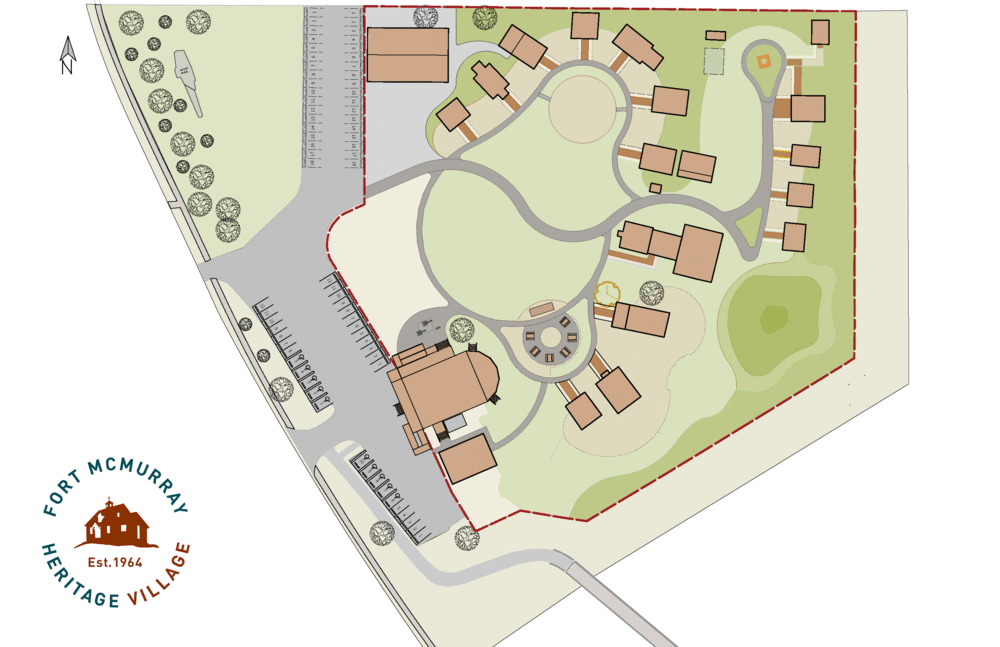About The Heritage Village
We have a collection of buildings, some dating back a century, each one inviting visitors to experience a different aspect of Fort McMurray’s past. Walk through history and explore the stories of those who came before. It’s a vibrant and captivating destination, and an essential part of our community.

Catholic Mission
The Catholic Mission was built in 1911 and was originally located on the eastern side of Franklin Avenue and Main Street. In 1958 the building was sold for firewood, but fortunately it was saved and moved to Heritage Village, where it now is home to the stories of work of the Catholic Church in the early 1900s.
Chateau Gai
The Chateau Gai building was constructed by Father Bern Will Brown and the Oblate Missionaries, and opened in 1960. It provided the Grey Nuns a retreat from their nursing and teaching duties. The building was moved to Heritage Village in 1983 and now is home to the stories of the Grey Nuns who touched the hearts and minds of the people of Fort McMurray as nurses and teachers.
Forest Service Cabin
Built in 2009 at Heritage Village, this cabin represents the Clausen stopover cabin, named for Edwin Clausen who built the original cabin at Clausen’s Landing in the 1930s. The building is typical of the cabins used for overnight stays by Forest Service officers when they travelled by dogsled or boat, and later by snowmobile, to check timber operations and trap lines.
Forest Service Shed
The Forest Service Shed was constructed in 2015 to house large artifacts related to forest management in the Fort McMurray area. This building houses two large artifacts essential for forest protection: a Bombardier snow machine, which transported forest service rangers to remote parts of the forest, and a boat that moved the rangers by river to the forests.
Golosky House
The Golosky House was built on what is now Marshall Street in 1921, along with barns, a shed, and a workshop. The house had no electricity. For many years, the family kept food cool by putting it into a bucket and lowering it into the well. Sometimes they built an icehouse and eventually they kept an icebox on the back porch to refrigerate food.
Presbyterian Church
Built in 1916 by Reverend D.C. McTavish, this was the first Presbyterian Church in Fort McMurray. Everything in the church was hand crafted. Reverend McTavish’s wife, Cassia, started the first Sunday school, as well as the first school in town.
The Church is used for various programs and is not open to the public for viewing. The Church also serves as a vital storage facility for our artifacts and collections.
Hill Drugs
Originally named Sutherland Pharmacy, partners Angus Sutherland and Walter Hill had this building constructed by Carpenter J.W. Mann in 1934 after a fire destroyed their previous pharmacy building. It is home to stories about building a business in the early days of Fort McMurray.
Hill Family House
This was the home of Walter and Gladys Hill and their two sons, David and Kenneth (Ken). In 1934, Walter and Gladys Hill had the house built on the south side of Manning Avenue across from St John’s Anglican Church. It is home to stories about family life in early Fort McMurray.
Royal Bank
This Royal Bank building was the third of five Royal Bank buildings in Fort McMurray. It was constructed after the former bank burnt to the ground on Christmas Eve, 1945. It was an essential part of our growing community and houses the stories of commerce in Fort McMurray.
Ryan Brothers Warehouse
The Ryan Brothers Warehouse was built in 1919 for local entrepreneurs and businessmen, the Ryan Brothers. It was located on the North side of Franklin Avenue just east of Father Mercredi Street. This building now houses stories of early entrepreneurship in Fort McMurray.
Schoolhouse
The Schoolhouse was built in 1938. Frank and Simone Goodwin rented the house from about 1948 until 1980. The building was donated to Heritage Village after the Goodwin family vacated it. It now is home to our schoolhouse exhibit.
Simone Carpentry Shop
The Simone Carpentry Shop was built before 1935 and was used first as a public hall. Joe Simone, local boat-builder and cabinet-maker, converted it into a woodworking workshop. It now houses stories of the trades that built Fort McMurray.
St. Aidan's Church
St. Aidan's Church was built in 1938 as the first permanent Anglican Church in Waterways. It was used as a schoolhouse from 1939 to 1942. Today, it's the site of weddings and services at Heritage Village.
Forest Service Cabin
Built in 2009 at Heritage Village, this cabin represents the Clausen stopover cabin, named for Edwin Clausen who built the original cabin at Clausen’s Landing in the 1930s. The building is typical of the cabins used for overnight stays by Forest Service officers when they travelled by dogsled or boat, and later by snowmobile, to check timber operations and trap lines.
Trading Post
The Trading Post building was built in the 1940s. Originally located near the Saline Creek road connecting Fort McMurray and Waterways, the cabin was moved to Heritage Village in 1973. It is now home to the stories of First Nations in the Fort McMurray area and of the early fur trade.
Trapper's Cabin
The Trapper's Cabin, once located at the west end of MacDonald Avenue, was built in 1941 and was the home of McMurray’s long-time residents, the Herbert and Agnes Graham family. It is now home to stories of the fur trade in our community.
Wop May's Home
From 1929 - 1935, this building was the home of Wilfrid Reid "Wop" May and his wife, Violet May. Wop May was a Canadian flying ace in World War I. He became one of Fort McMurray's most renowned bush pilots. The building is now is home to the stories of early air mail and bush pilots.
